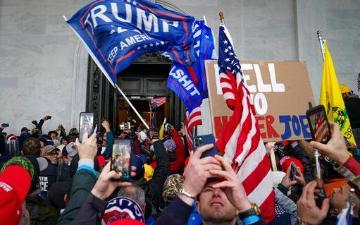
John Minchillo/Associated Press
This post was adapted from the author’s comment to TheFulrcum.us, and published originally here.
Subbu Vincent is the director of Journalism & Media Ethics at the Markkula Center for Applied Ethics. He tweets from @subbuvincent and @jmethics and views are his own.
If we were to compare the summer 2020 Black Lives Matter protests and riots and the January 6, 2021 protests and insurrection, would we learn anything? It is meaningful to compare the two because it takes us to the heart of how ethics in public action is tied to the democratic way of life. It is tied to the meaning of the word “democratic.” So let’s give it a try. It would be easy to start with how dissimilar the two were. But let’s start with the similarities first, because there are some.
Both were profound examples of collective human agency at work to bring about change. In both cases, there were large numbers of peaceful protestors. In both cases, elected political leaders supported the movements. In both cases, public property was attacked, with the insurrectionists of Jan. 6 singularly attacking the seat of the U.S. Congress itself. Both had violent protesters. Both movements have a long historical backdrop with individual contemporary events becoming flashpoints. Jan 6th was triggered by the former president’s election loss. BLM protests were triggered by George Floyd's killing on video by a white police officer even after Floyd had followed orders. Another similarity: social media helped both movements organize, build networks, and spread the word.
The dissimilarities are striking
BLM protests were an outpouring of human agency and an assertion of democratic power of the people. They were bottom-up, and not led from the top by a single leader. They drew moral power from the long-running truth about systemic and brutal racism in the American police and criminal justice systems. On the other hand, the Jan 6, 2021 insurrection was based on a big lie, i.e. the opposite of the truth. It attempted to stop an election certification that had survived multiple rounds of audits and evidence-based court battles. It was the definition of anti-democratic. It was both top-down, created and led by a supreme leader in the GOP, and bottom-up, fueled by a conspiracy theory started by the former president in early 2020 to intentionally stage a counter-punch movement in the event of an election loss.
BLM summer ’20 came in the backdrop of protests and riots running from 2014 in Ferguson through several more police killings of black men and women, all the way to George Floyd and Brionna Taylor in 2020. They were largely peaceful with some incidents of violence, while at the Jan 6th protests, a small number of frontline extremists had shockingly come prepared to enact executions such as hanging the vice president. While there were peacefully gathered protestors on Jan 6th who did not attack the capitol, they also believed and still believe in the big lie. They formed the reservoir of sentimental support and legitimacy for the actual insurrectionists. They lost the capacity to judge, because they were lied to repeatedly by their leaders. (Hannah Arendt said when you lie to people repeatedly, they lose their capacity to judge.)
The Jan 6th insurrection was largely an action taken by white people. The organizing groups who attacked the capitol, were overwhelmingly white, and included people carrying Confederacy symbols evoking nostalgia for a past where white power was unquestioned in American democracy. The BLM summer '20 movement on the other hand was a visible multiracial and democratic coalition, with people from a range of racial, caste, and ethnic and marginalized groups.
